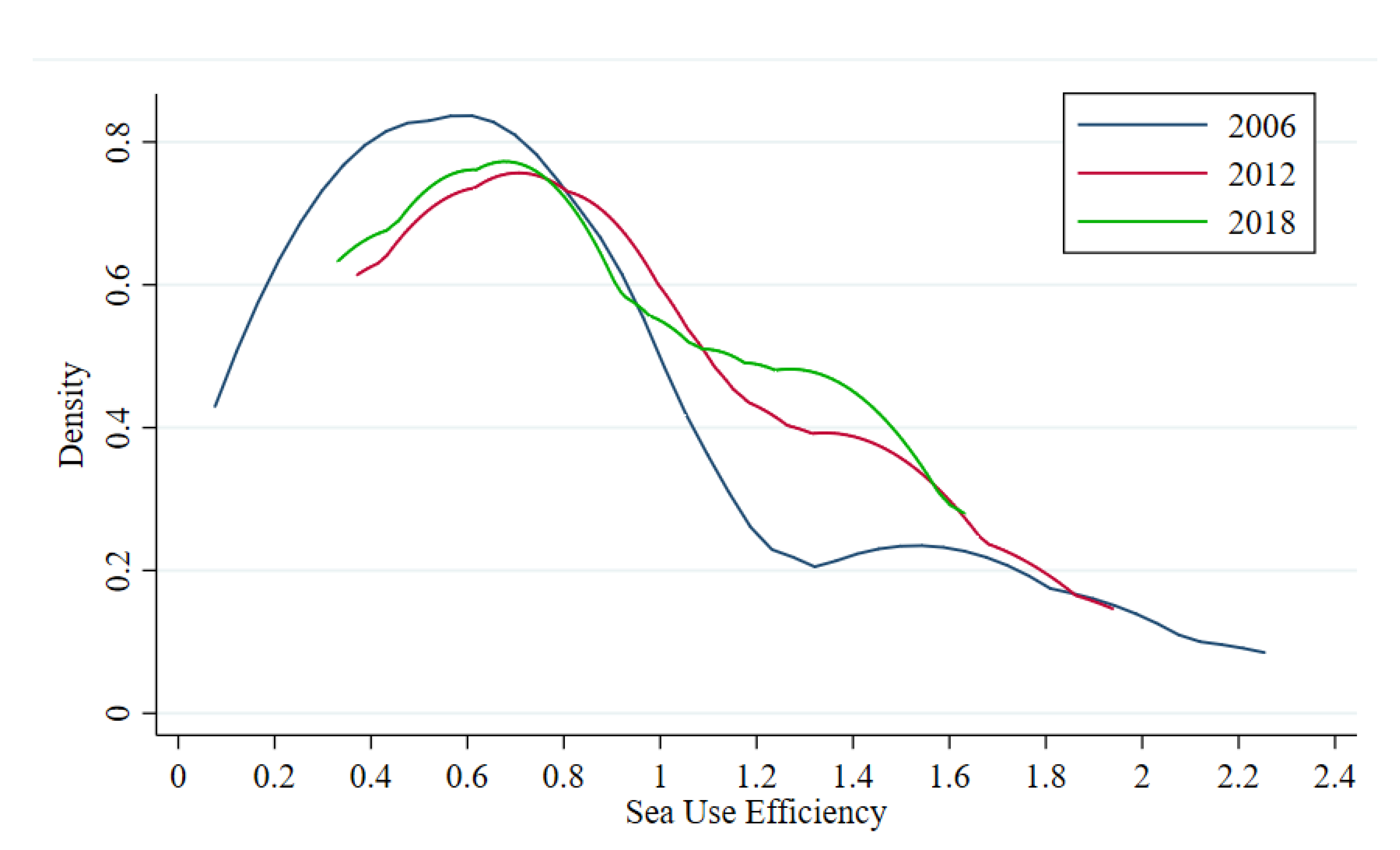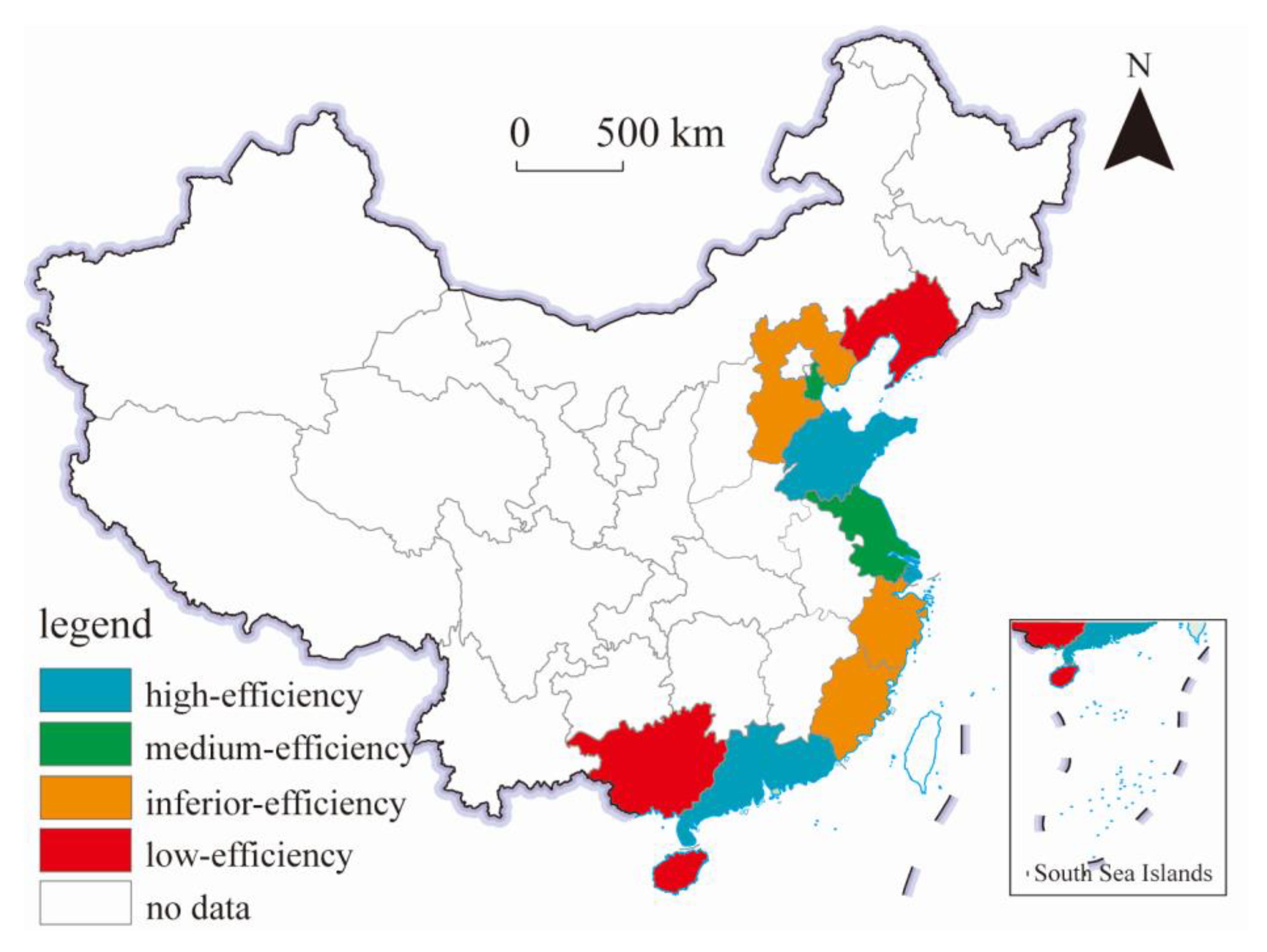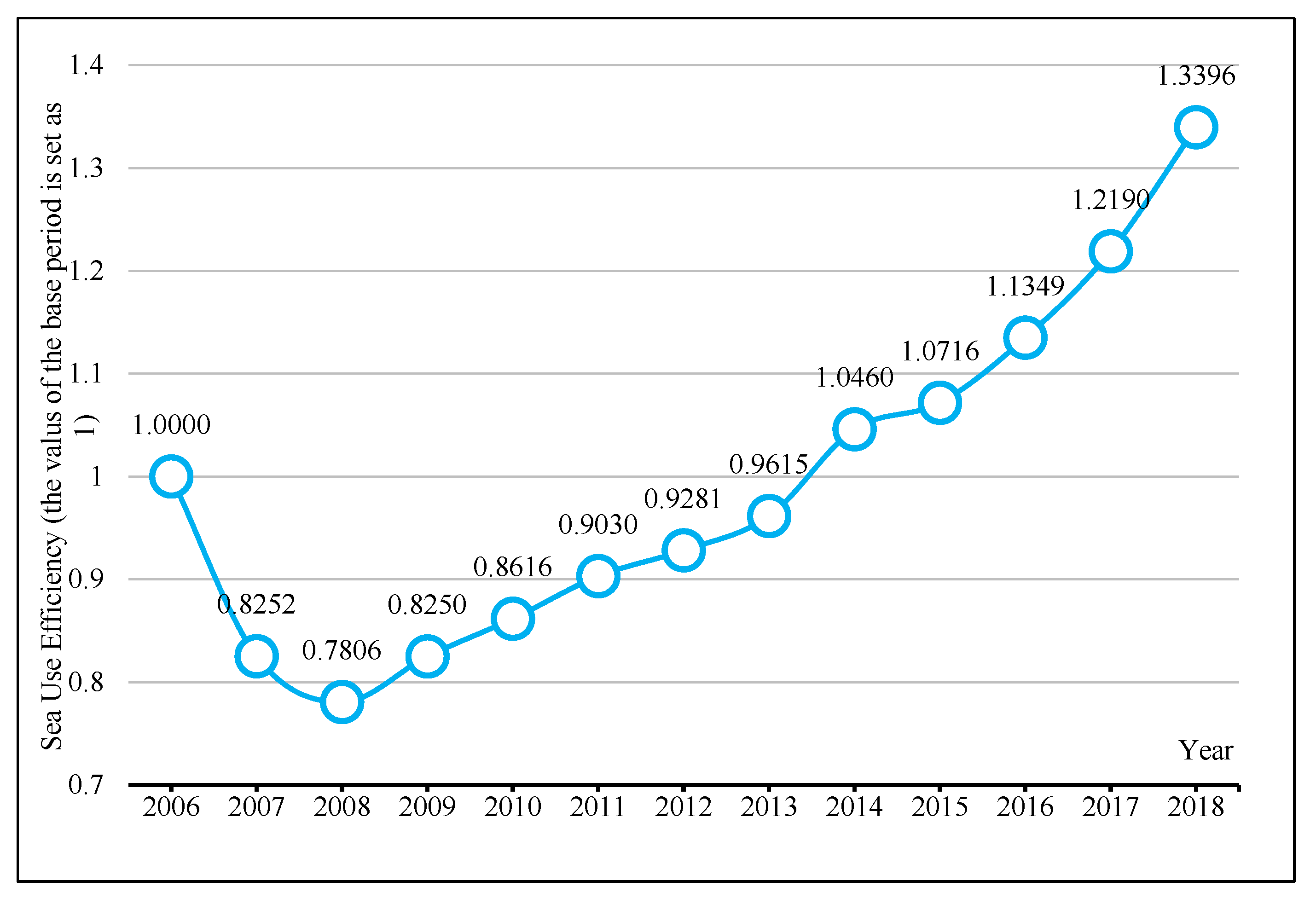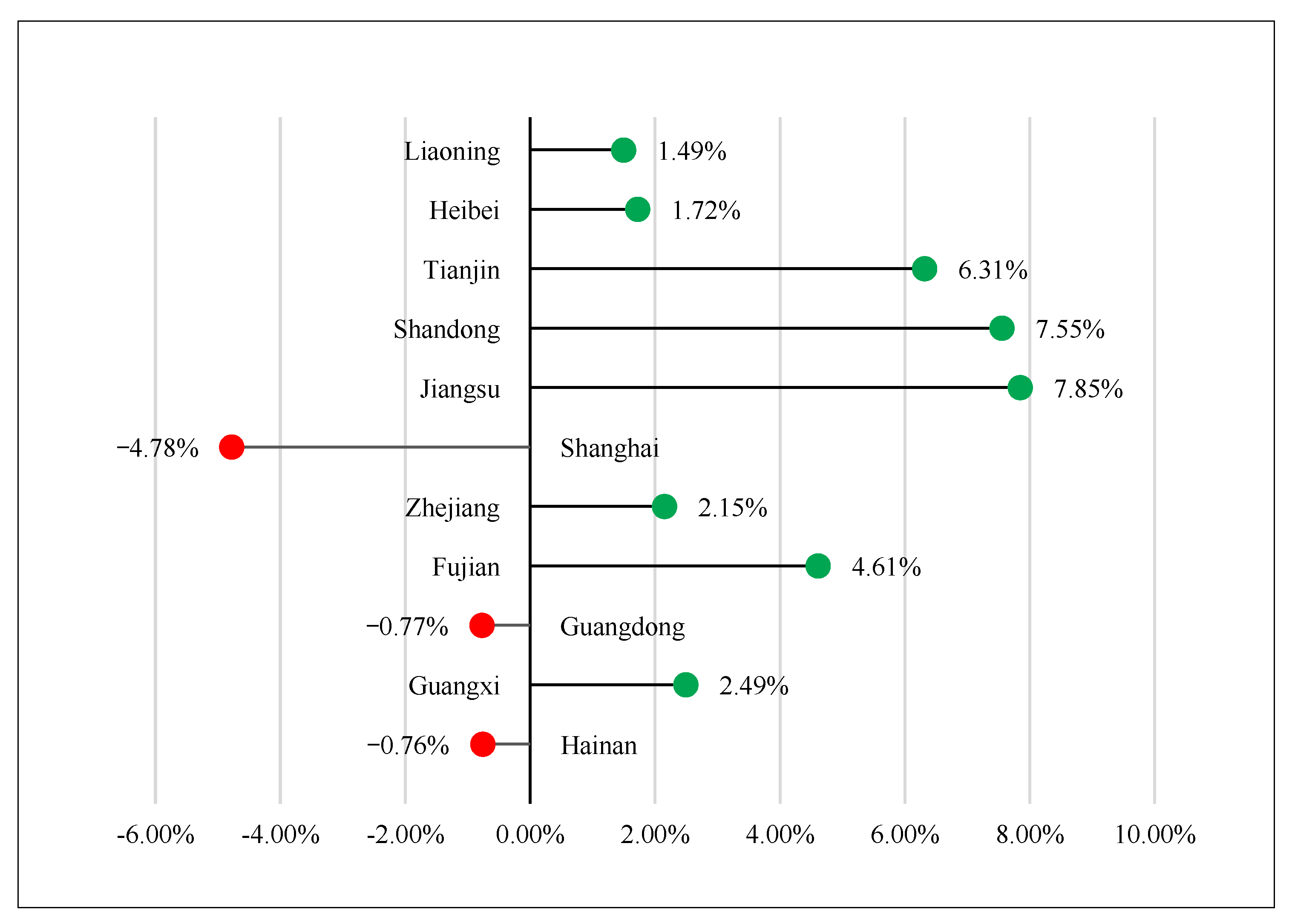Regional Differences and Dynamic Changes in Sea Use Efficiency in China
Abstract
1. Introduction
2. Materials and Methods
2.1. Super-WSBM Model
2.2. GML Index
2.3. EC Index and BPC Index
3. Indicator Selection and Data Sources
4. Result
4.1. General Evaluation of SUE
- (1)
- In the center of the density function, the center value in 2006 is the lowest, roughly 0.6, and the center values in 2012 and 2018 are not very different, both within the range of 0.7–0.8. The results indicate that, on the one hand, from the overall national level, the SUE is at the medium level, not reaching the high status; on the other hand, there exists a growth trend in the efficiency from low to medium level.
- (2)
- The peak is highest in 2006, indicating a more concentrated distribution of SUE values in 2006.
- (3)
- In terms of the number of wave crests, there exist two crests in 2006 and 2018 and one in 2012. Thus, a polarization of SUE transpired in 2006 and 2018. Further observation of the peak values shows that the value of the second peak in 2018 is significantly larger than that in 2006 and the gap between the two peaks is smaller. Therefore, during the examination period, the polarization of SUE has intensified, showing a “club convergence” pattern with L–L and H–H clusters.
- (4)
- In the tail part, the kernel density distribution maps for all three years show a right-skewed distribution. Thus, more areas are distributed on the right than on the left, signifying that more areas have SUE values greater than the average.
4.2. Regional Differences in SUE
- (1)
- Shanghai (1.8607), Guangdong (1.4084), and Shandong (1.1920) are high-efficiency regions where their SUE has reached the frontier every year, among which Shanghai keeps far ahead. These three places boast a solid economic foundation for marine development as a result of the early exploitation of their waters. According to the 2018 data, they accounted for more than half of the country’s GMP (gross marine product). They also play a central role in China’s three major marine economic circles (northern, eastern, and southern marine economic circles), respectively, equipped with advanced technologies and brilliant talents for marine development. When combined with various policies to support marine development, the above three locations have taken the lead in SUE and have maintained it for a long time.
- (2)
- Jiangsu (0.9619) and Tianjin (0.9295) are medium-efficiency regions. Their SUE reached the frontier in 2008 and 2010. As developed provinces in eastern China, they pay increasing attention to the marine economy although they lag behind Shanghai, Guangdong, and Shandong in terms of time of sea exploitation. Given their solid economic foundation and abundant marine resources, they have made ongoing efforts to increase research and investment in marine development technology, formulating a series of favorable policies to attract talents for marine economy development. Concurrently, they have strived to utilize the spillover effect from their neighbors, Shandong and Shanghai, so that their sea use efficiencies continue to rise and remain at a medium level.
- (3)
- Fujian (0.6200), Hebei (0.5983), and Zhejiang (0.5632) are inferior-efficiency regions. Their SUE failed to reach the frontier during the examination. Similar to Jiangsu and Tianjin, as developed provinces in coastal areas, Fujian and Zhejiang have advantages in marine technology and scale of marine economy. However, given the poor marine ecological environment near the East China Sea where Zhejiang and Fujian are located, as well as the lack of marine ecological environmental protection in the process of exploitation, undesirable outputs such as inorganic nitrogen and reactive phosphate are excessively high, followed by a lower SUE. Compared with other coastal areas, Hebei is endowed with fewer marine resources, with only three coastal cities in the province. In addition, the sea development does not count as the focus of its overall economic development. It places little emphasis on the integrated use of its waters, causing its marine economic development to stagnate. Therefore, a large gap exists between its SUE and that of its neighbors, Tianjin and Shandong.
- (4)
- Liaoning (0.4242), Hainan (0.3908), and Guangxi (0.3722) are low-efficiency regions where their SUE in the examination period was far from reaching the frontier. Despite their generous investment in production factors during their marine development, their GMP is incredibly out of proportion with the input due to the problematic marine industry structure. Liaoning and Guangxi are lacking in the advanced marine industry, as fishery remains the primary marine industry with low added-value from the marine economic output. Hainan has a sound marine ecological environment and depends heavily on tourism for its marine development. However, such over-dependence on tourism brings about the laggard development of strategic emerging marine industries that can really drive the overall growth of the regional marine economy. Furthermore, its unreasonable marine industry structure results in obviously insufficient regional marine economic output.
4.3. Dynamic Changes in SUE
- (1)
- Declining period (2006–2008): In this period, although the human, material, and financial resources invested in the process of marine exploitation were increasing, the paid use system of the sea remained in the initial implementation phase where the supporting mechanisms were not in place. As a result, the system arrangement of the sea property rights system did not play an efficient role in promoting the SUE. Concurrently, the development of China’s marine economy remained in its infancy where the technologies for marine exploitation were disadvantaged, and the marine industry was dominated by the marine secondary industry with low added-value and a great impact on the marine ecological environment. Consequently, the growth rate of marine economic output failed to match the growth rate of its input. Coupled with the lack of attention to marine environmental protection, the damage to marine ecology further imposed negative externalities on the improvement of SUE.
- (2)
- Steady increase period (2008–2013): In this period, as various supporting mechanisms were in place, the implementation of the paid use system of the sea was greatly promoted, and the system arrangement of sea property played a better role in promoting the SUE. As a result, the SUE in China rose steadily in this period with the geometric mean of the GML index being 1.0428 and the average annual growth rate maintained within 2–5%.
- (3)
- Rapid increase period (2013–2018): At the 18th National Congress of the Communist Party of China, the national strategy of “building China into a strong marine country” was formulated. The strategy proposes that the construction of a strong marine country should be promoted from various aspects, including marine economy, marine sciences and technologies, and the marine environment. Consequently, China’s marine industries thrived, and the SUE experienced a rapid rise. Over the years, the geometric mean of the GML index was 1.0686 and the average annual growth rate exceeded 5%, indicating a continuous rise in SUE.
5. Discussions
6. Conclusions and Remarks on Future Research
- (1)
- Nationally speaking, at the end of the examination period the central value in the density function of SUE was distributed between 0.7 and 0.8, which has not reached the high-efficiency level. During the examination period, the efficiency of sea use has experienced a declining period (2006–2008), a steady increase period (2008–2013), and a rapid increase period (2013–2018). The increase in China’s SUE during the examination period is mainly driven by the advancement in technologies and shows a “checkmark” type with an average annual growth rate of 2.47%.
- (2)
- Looking from a regional view, significant regional differences exist in the efficiency of sea use, and the degree of polarization has been strengthened. Shanghai (1.8607), Guangdong (1.4084), and Shandong (1.1920) are high-efficiency regions. However, in contrast to Shandong, where the efficiency has risen rapidly, Shanghai and Guangdong show different degrees of decline in SUE, with the decline in Shanghai being particularly significant; Jiangsu (0.9619) and Tianjin (0.9295) belong to medium-efficiency regions with high growth in SUE. Fujian (0.6200), Hebei (0.5983), and Zhejiang (0.5632) are regions with inferior efficiency where a small increase in SUE can be seen; Liaoning (0.4242), Hainan (0.3908), and Guangxi (0.3722) are regions with low efficiency; excluding Hainan, where a slight decline in efficiency transpired, Liaoning and Guangxi experienced a small rise in efficiency during the examination period.
Author Contributions
Funding
Institutional Review Board Statement
Informed Consent Statement
Data Availability Statement
Conflicts of Interest
References
- Yang, X.; Liu, N.; Zhang, P.; Guo, Z.; Ma, C.; Hu, P.; Zhang, X. The current state of marine renewable energy policy in China. Mar. Policy 2019, 100, 334–341. [Google Scholar] [CrossRef]
- Yu, H. A new stage in China’s marine management. Ocean Coast. Manag. 1993, 19, 185–190. [Google Scholar] [CrossRef]
- Yang, L.; Wu, L.; Yan, S. Market-based sea use management in China: Features and countermeasures. Mar. Policy 2020, 120, 104091. [Google Scholar] [CrossRef]
- He, S.; Zhai, R.; Pan, Y. Modeling analysis of the relationship between the exploitation and utilization of marine resources and the sustainable development of the marine economy. J. Coast. Res. 2018, 83, 964–969. [Google Scholar] [CrossRef]
- Wang, L.; Zhang, H. The impact of marine tourism resources development on sustainable development of marine economy. J. Coast. Res. 2019, 94, 589–592. [Google Scholar] [CrossRef]
- Greiner, R.; Young, M.; McDonald, A.; Brooks, M. Incentive instruments for the sustainable use of marine resources. Ocean Coast. Manag. 2000, 43, 29–50. [Google Scholar] [CrossRef]
- Scheiber, H.N. The “commons” discourse on marine fisheries resources: Another antecedent to Hardin’s “tragedy”. Theor. Inq. Law 2018, 19, 489–505. [Google Scholar] [CrossRef]
- Chang, J.I.; Choi, H.J.; Choi, S. Challenges of the coastal use fee and levy system in Korea. J. Coast. Res. 2018, 85, 1511–1515. [Google Scholar] [CrossRef]
- Englander, G. Property rights and the protection of global marine resources. Nat. Sustain. 2019, 2, 981–987. [Google Scholar] [CrossRef]
- Posner, E.A.; Sykes, A.O. Economic foundations of the law of the sea. Am. J. Int. Law 2010, 104, 569–596. [Google Scholar] [CrossRef]
- Ostrom, E. Governing the Commons: The Evolution of Institutions for Collective Action; Cambridge University Press: Cambridge, UK, 1990. [Google Scholar]
- Tingley, D.; Pascoe, S.; Coglan, L. Factors affecting technical efficiency in fisheries: Stochastic production frontier versus data envelopment analysis approaches. Fish. Res. 2005, 73, 363–376. [Google Scholar] [CrossRef]
- Idda, L.; Madau, F.A.; Pulina, P. Capacity and economic efficiency in small-scale fisheries: Evidence from the Mediterranean Sea. Mar. Policy 2009, 33, 860–867. [Google Scholar] [CrossRef]
- Jamnia, A.; Mazloumzadeh, S.; Keikha, A. Estimate the technical efficiency of fishing vessels operating in Chabahar region, Southern Iran. J. Saudi Soc. Agric. Sci. 2015, 14, 26–32. [Google Scholar] [CrossRef]
- Kamble, S.S.; Raoot, A.D.; Khanapuri, V.B. Improving port efficiency: A comparative study of selected ports in India. Int. J. Shipp. Transp. Logist. 2010, 2, 444–470. [Google Scholar] [CrossRef]
- Cullinane, K.; Wang, T.-F.; Song, D.-W.; Ji, P. The technical efficiency of container ports: Comparing data envelopment analysis and stochastic frontier analysis. Transp. Res. Part A Policy Pract. 2006, 40, 354–374. [Google Scholar] [CrossRef]
- Fancello, G.; Serra, P.; Aramu, V.; Vitiello, D.M. Evaluating the efficiency of Mediterranean container ports using data envelopment analysis. Compet. Regul. Netw. Ind. 2021, 22, 163–188. [Google Scholar] [CrossRef]
- Lei, L.; Gao, Q.X.; Yang, C. The variations and trend analyses of sea area use in China. Resour. Sci. 2017, 39, 2030–2039. [Google Scholar] [CrossRef][Green Version]
- Yueying, C.; Quanming, Z.; Weiwei, W. Situations and Suggestions on Paid Use of Sea Area in China. Ocean Dev. Manag. 2012, 29, 9–13. [Google Scholar] [CrossRef]
- Lina, K.; Hongqing, W.; Shusheng, Y. Study on Sea Areas Intensive Use in Liaoning Coastal Economic Zone from 2004 to 2014. Trans. Oceanol. Limnol. 2018, 4, 148–156. [Google Scholar] [CrossRef]
- Hongwei, M.; Shaoquan, G.; Weiwei, W. Evaluation of marine utilization: A case study of Dalian City. Mar. Environ. Sci. 2012, 2, 282–284. [Google Scholar]
- Si, Z.; Miao, W. Empirical Research on Paid Use of Sea Area in China: 2002–2017. China Soft Sci. 2018, 8, 148–164. [Google Scholar] [CrossRef]
- Tone, K. A slacks-based measure of efficiency in data envelopment analysis. Eur. J. Oper. Res. 2001, 130, 498–509. [Google Scholar] [CrossRef]
- Tone, K. A slacks-based measure of super-efficiency in data envelopment analysis. Eur. J. Oper. Res. 2002, 143, 32–41. [Google Scholar] [CrossRef]
- Zhaofeng, W.; Qingfang, L. The spatio-temporal evolution of tourism eco-efficiency in the Yangtze River Economic Belt and its interactive response with tourism economy. J. Nat. Resour. 2019, 9, 1945–1961. [Google Scholar] [CrossRef]
- Oh, D.H. A global Malmquist-Luenberger productivity index. J. Product. Anal. 2010, 34, 183–197. [Google Scholar] [CrossRef]
- Mei, G.; Yarong, Z. Spatial Evolution of Marine Ecological Efficiency and Its Influential Factors in China Coastal Regions. Sci. Geogr. Sin. 2019, 4, 616–625. [Google Scholar] [CrossRef]
- Hongjun, G.; Zhenzhen, S.; Haonan, G. An analysis of Spatial-temporal Evolution of Marine Economy Green Total Factors Productivity and Its Influencing Factors in China. J. Ocean Univ. China Soc. Sci. 2019, 6, 40–53. [Google Scholar] [CrossRef]
- Lin, Z.; Yushuo, Z.; Xinying, J. An evaluation of Chinese marine economy efficiency based on SBM and Malmquist productivity indexes. Resour. Sci. 2016, 3, 461–475. [Google Scholar] [CrossRef]
- Qingfeng, W.; Zhuchang, T. Estimating of Capital Stock without Investment Information. J. Quant. Tech. Econ. 2014, 9, 150–160. [Google Scholar] [CrossRef]
- Jun, Z.; Guiying, W.; Jipeng, Z. The Estimation of China’s provincial capital stock: 1952—2000. Econ. Res. J. 2004, 10, 35–44. [Google Scholar]
- Young, A. Gold into base metals: Productivity growth in the People’s Republic of China during the reform period. J. Political Econ. 2003, 111, 1220–1261. [Google Scholar] [CrossRef]
- Hefeng, W.; Yishao, S.; Changying, Y. Land use efficiencies and their changes of Shanghai’s development zones employing DEA model and Malmquist productivity index. Geogr. Res. 2014, 9, 1636–1646. [Google Scholar]
- Bin, Q.; Shuai, Y.; Peijiang, X. Research on Technology Spillover of FDI and China’s Manufacturing Productivity: Based on the Panel Data. J. World Econ. 2008, 8, 20–31. [Google Scholar] [CrossRef]
- Xuan, Y.; Sen, L.; Weiteng, S.; Qi, C. The tiered transaction system for sea use rights in China: Theoretical basis and market construction. Mar. Policy 2022, 147, 105403. [Google Scholar] [CrossRef]




| Indicator Type | Variable | Data Sources |
|---|---|---|
| Input | Marine employment (10,000) | China Marine Statistical Yearbook |
| Marine capital stock (CNY 100 million) | China Marine Statistical Yearbook and China Statistical Yearbook | |
| Cumulative sea area with confirmed use rights (hectare) | China Marine Statistical Yearbook and Bulletin on Sea Area Use Management in China | |
| Royalty charged (CNY 10,000) | China Marine Statistical Yearbook | |
| Output | Gross marine product (CNY 100 million) | China Marine Statistical Yearbook |
| Average concentration of inorganic nitrogen in offshore seawater (mg/L) | Bulletin on Environmental Quality of Offshore Waters in China | |
| Average concentration of reactive phosphate in offshore seawater (mg/L) | Bulletin on Environmental Quality of Offshore Waters in China |
| Year | Type | Liaoning | Hebei | Tianjin | Shandong | Jiangsu | Shanghai | Zhejiang | Fujian | Guangdong | Guangxi | Hainan |
|---|---|---|---|---|---|---|---|---|---|---|---|---|
| 2006 | SUE | 0.4451 | 0.5919 | 0.6883 | 1.1712 | 0.5245 | 1.9669 | 0.5780 | 0.5309 | 1.4548 | 0.3632 | 0.4089 |
| Ranking | 9 | 5 | 4 | 3 | 8 | 1 | 6 | 7 | 2 | 11 | 10 | |
| 2007 | SUE | 0.5039 | 0.6308 | 0.6146 | 1.1898 | 0.5494 | 1.8785 | 0.6567 | 0.6773 | 1.2805 | 0.4494 | 0.5418 |
| Ranking | 10 | 6 | 7 | 3 | 8 | 1 | 5 | 4 | 2 | 11 | 9 | |
| 2008 | SUE | 0.5078 | 0.5816 | 0.5573 | 1.1742 | 1.0479 | 1.9497 | 0.6323 | 0.6268 | 1.2589 | 0.4361 | 0.4297 |
| Ranking | 9 | 7 | 8 | 3 | 4 | 1 | 5 | 6 | 2 | 10 | 11 | |
| 2009 | SUE | 0.4509 | 0.6942 | 0.6316 | 1.1479 | 1.0386 | 1.8914 | 0.6338 | 0.5670 | 1.3608 | 0.3801 | 0.4049 |
| Ranking | 9 | 5 | 7 | 3 | 4 | 1 | 6 | 8 | 2 | 11 | 10 | |
| 2010 | SUE | 0.3933 | 0.5188 | 1.0558 | 1.2418 | 1.0160 | 1.9621 | 0.5708 | 0.5626 | 1.3703 | 0.3760 | 0.3947 |
| Ranking | 10 | 8 | 4 | 3 | 5 | 1 | 6 | 7 | 2 | 11 | 9 | |
| 2011 | SUE | 0.4067 | 0.4837 | 1.0173 | 1.1890 | 1.0480 | 1.9423 | 0.5556 | 0.5981 | 1.3294 | 0.3305 | 0.3525 |
| Ranking | 9 | 8 | 5 | 3 | 4 | 1 | 7 | 6 | 2 | 11 | 10 | |
| 2012 | SUE | 0.4325 | 0.4892 | 1.0385 | 1.2387 | 1.0570 | 1.9387 | 0.5593 | 0.6403 | 1.4316 | 0.3714 | 0.5282 |
| Ranking | 10 | 9 | 5 | 3 | 4 | 1 | 7 | 6 | 2 | 11 | 8 | |
| 2013 | SUE | 0.4141 | 0.5937 | 1.0656 | 1.1792 | 1.0420 | 1.9515 | 0.5112 | 0.6138 | 1.4243 | 0.3776 | 0.3482 |
| Ranking | 9 | 7 | 4 | 3 | 5 | 1 | 8 | 6 | 2 | 10 | 11 | |
| 2014 | SUE | 0.3962 | 0.6831 | 1.1937 | 1.2298 | 1.0616 | 1.9291 | 0.5403 | 0.6391 | 1.4085 | 0.3466 | 0.3511 |
| Ranking | 9 | 6 | 4 | 3 | 5 | 1 | 8 | 7 | 2 | 11 | 10 | |
| 2015 | SUE | 0.3353 | 0.6087 | 1.1179 | 1.1580 | 1.0496 | 1.8845 | 0.5152 | 0.6106 | 1.4580 | 0.3416 | 0.3132 |
| Ranking | 10 | 7 | 4 | 3 | 5 | 1 | 8 | 6 | 2 | 9 | 11 | |
| 2016 | SUE | 0.3765 | 0.5806 | 1.0419 | 1.2082 | 1.0398 | 1.6248 | 0.5223 | 0.5975 | 1.5180 | 0.3404 | 0.3369 |
| Ranking | 9 | 7 | 4 | 3 | 5 | 1 | 8 | 6 | 2 | 10 | 11 | |
| 2017 | SUE | 0.4467 | 0.6425 | 1.0320 | 1.1774 | 1.0259 | 1.6385 | 0.5306 | 0.7297 | 1.5242 | 0.3689 | 0.3389 |
| Ranking | 9 | 7 | 4 | 3 | 5 | 1 | 8 | 6 | 2 | 10 | 11 | |
| 2018 | SUE | 0.4052 | 0.6025 | 1.0296 | 1.1910 | 1.0049 | 1.6313 | 0.5152 | 0.6667 | 1.4895 | 0.3561 | 0.3312 |
| Ranking | 9 | 7 | 4 | 3 | 5 | 1 | 8 | 6 | 2 | 10 | 11 |
| Period | GML | EC | BPC |
|---|---|---|---|
| 2006–2007 | 0.8252 | 1.0782 | 0.7654 |
| 2007–2008 | 0.9459 | 1.0095 | 0.9369 |
| 2008–2009 | 1.0569 | 0.9913 | 1.0662 |
| 2009–2010 | 1.0444 | 1.0034 | 1.0408 |
| 2010–2011 | 1.0481 | 0.9700 | 1.0805 |
| 2011–2012 | 1.0278 | 1.0766 | 0.9547 |
| 2012–2013 | 1.0360 | 0.9627 | 1.0761 |
| 2013–2014 | 1.0879 | 1.0245 | 1.0619 |
| 2014–2015 | 1.0245 | 0.9443 | 1.0849 |
| 2015–2016 | 1.0591 | 1.0098 | 1.0487 |
| 2016–2017 | 1.0741 | 1.0384 | 1.0344 |
| 2017–2018 | 1.0989 | 0.9662 | 1.1374 |
| 2006–2018 | 1.0247 | 1.0054 | 1.0191 |
Publisher’s Note: MDPI stays neutral with regard to jurisdictional claims in published maps and institutional affiliations. |
© 2022 by the author. Licensee MDPI, Basel, Switzerland. This article is an open access article distributed under the terms and conditions of the Creative Commons Attribution (CC BY) license (https://creativecommons.org/licenses/by/4.0/).
Share and Cite
Zhang, Q.; Yu, X. Regional Differences and Dynamic Changes in Sea Use Efficiency in China. J. Mar. Sci. Eng. 2022, 10, 1848. https://doi.org/10.3390/jmse10121848
Zhang Q, Yu X. Regional Differences and Dynamic Changes in Sea Use Efficiency in China. Journal of Marine Science and Engineering. 2022; 10(12):1848. https://doi.org/10.3390/jmse10121848
Chicago/Turabian StyleZhang, Qian, and Xuan Yu. 2022. "Regional Differences and Dynamic Changes in Sea Use Efficiency in China" Journal of Marine Science and Engineering 10, no. 12: 1848. https://doi.org/10.3390/jmse10121848
APA StyleZhang, Q., & Yu, X. (2022). Regional Differences and Dynamic Changes in Sea Use Efficiency in China. Journal of Marine Science and Engineering, 10(12), 1848. https://doi.org/10.3390/jmse10121848






